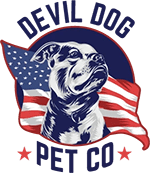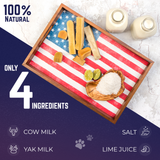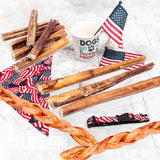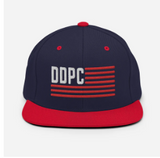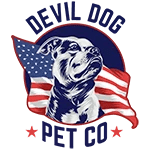What Are Marrow Bones for Dogs?
Every responsible dog owner has stood in the pet store aisle, staring at rows of marrow bones for dogs, wondering if they're making the right choice. Your pup's excited tail-wagging says "yes," but conflicting advice from friends, forums, and even veterinarians leaves you second-guessing.
Key Takeaways
- Marrow bones for dogs come from cattle, lamb, or bison and contain nutrient-rich marrow.
- Raw marrow bones are safer than cooked ones because cooked bones can splinter and cause injuries.
- Marrow bones provide both dental and nutritional benefits for dogs.
- Always supervise your dog while they chew on marrow bones.
- Choose appropriately sized bones to ensure your dog's safety.
Table of Contents
- What Are Marrow Bones for Dogs?
- Understanding Marrow Bones: More Than Just a Chew
- The Nutritional Powerhouse: What Makes Bone Marrow Good for Dogs
- Raw vs. Cooked: The Safety Equation That Changes Everything
- How to Safely Prepare and Feed Marrow Bones: The Devil Dog Protocol
- Recognizing Danger Signs and Smarter Alternatives
- The Extreme Leadership Decision on Marrow Bones
Here's the unfiltered truth: marrow bones for dogs aren't a simple yes-or-no decision. They're a calculated risk that demands your full attention as a leader. When sourced correctly, sized appropriately, and supervised religiously, they can deliver powerful benefits for your dog's dental health, mental stimulation, and nutritional needs. Get it wrong, and you're looking at emergency vet bills and a dog in serious distress.
At Devil Dog Pet Co., we've seen both sides of this debate play out in real time. Our dog Dexter taught us early that not all chews are created equal, and that owner education trumps marketing hype every single time. This guide cuts through the noise to give you the facts you need to make an informed decision about whether marrow bones for dogs belong in your leadership toolkit.
We'll cover what makes marrow bones appealing to dogs, the nutritional science behind bone marrow, the critical differences between raw and cooked options, and most importantly—how to minimize risks if you choose to offer them. Whether you're a new dog owner or a seasoned handler questioning your approach, this comprehensive breakdown will arm you with the knowledge to lead with confidence.
Understanding Marrow Bones: More Than Just a Chew

Marrow bones for dogs are exactly what they sound like—bones from large mammals that contain marrow, the soft, fatty tissue found inside bone cavities. Most commonly sourced from beef cattle, these bones can also come from lamb, bison, or other large ungulates. The marrow itself is what makes these bones so appealing to dogs and so nutritionally dense.
Physically, marrow bones are typically cut into 3-6 inch sections from the femur, tibia, or humerus of the animal. The outer bone provides the hard chewing surface dogs crave, while the inner marrow delivers rich flavors and nutrients that keep them engaged for extended periods. This combination of texture and taste explains why can dogs eat marrow bones remains one of the most searched questions among dog owners.
The appeal goes beyond simple entertainment. When dogs gnaw on marrow bones, they're engaging in a behavior that mirrors their ancestral feeding patterns. The scraping action naturally cleans teeth, the extended chewing provides mental stimulation, and the marrow delivers concentrated nutrition that commercial treats often lack.
However, not all marrow bones are created equal. The source animal's diet, the bone's freshness, and how it's processed all impact both safety and nutritional value. Grass-fed cattle typically produce marrow with higher levels of omega-3 fatty acids and vitamins compared to grain-fed alternatives. Fresh or properly frozen bones maintain their structural integrity better than those that have been stored improperly or for extended periods.
Understanding these fundamentals sets the foundation for making informed decisions about marrow bones for dogs. The next critical piece of the puzzle is understanding exactly what nutritional benefits these bones can provide—and whether those benefits justify the risks involved.
The Nutritional Powerhouse: What Makes Bone Marrow Good for Dogs
When evaluating is bone marrow good for dogs, the nutritional profile tells a compelling story. Bone marrow is essentially nature's multivitamin—packed with fat-soluble vitamins, essential minerals, and bioactive compounds that many commercial dog foods struggle to replicate.
The marrow itself contains high concentrations of vitamin A for immune function and vision, vitamin K2 for bone metabolism, and B12 for neurological health. Iron and zinc support oxygen transport and wound healing, while the healthy fats provide sustained energy and promote coat shine. This nutrient density explains why what is bone marrow good for extends far beyond simple entertainment.
But here's where it gets interesting for dog owners: the bone structure surrounding the marrow contributes its own nutritional benefits. Calcium and phosphorus maintain dental health and bone strength, while collagen, glucosamine, and chondroitin support joint function—particularly valuable for aging dogs or active breeds prone to joint stress.
The mental stimulation component shouldn't be overlooked either. Extended chewing sessions release endorphins, reduce anxiety, and provide an outlet for natural behaviors. This makes marrow bone nutrition about more than just vitamins and minerals—it's about overall behavioral health.
However, these benefits come with important caveats. The high fat content in marrow can trigger pancreatitis in susceptible dogs, and the rich nature of the treat means portion control is critical. A dog that devours marrow too quickly may experience digestive upset, regardless of the nutritional benefits.
Raw vs. Cooked: The Safety Equation That Changes Everything

The question of can dogs eat marrow bones raw versus cooked isn't just about preference—it's about fundamental safety. This distinction represents the difference between a calculated risk and a dangerous gamble with your dog's health.
Raw marrow bones maintain their natural flexibility and density. The bone structure remains intact, making them less likely to splinter into sharp fragments that can lacerate your dog's mouth, throat, or digestive tract. When dogs ask can dogs eat raw marrow bones, the answer involves understanding this structural integrity.
Cooked bones, on the other hand, undergo a chemical transformation that makes them brittle and prone to splintering. The heat process removes moisture and breaks down the collagen matrix that gives bones their flexibility. This is why veterinarians universally warn against cooked bones of any kind.
| Aspect | Raw Marrow Bones | Cooked Marrow Bones |
|---|---|---|
| Splintering Risk | Lower (but still present) | Very High |
| Nutritional Value | Maximum retention | Significantly reduced |
| Bacterial Risk | Present (requires handling precautions) | Reduced but not eliminated |
| Digestibility | Better for small fragments | Harder, more likely to cause blockages |
| Veterinary Recommendation | Cautious approval with supervision | Strongly discouraged |
The bacterial concern with raw bones is real but manageable. Salmonella and E. coli can be present on raw bones, requiring the same food safety protocols you'd use for raw meat preparation. This means proper storage, clean surfaces, and immediate cleanup after chewing sessions.
For owners wondering can dogs eat beef marrow bones specifically, beef bones tend to be denser and longer-lasting than other options, but they also carry a higher risk of tooth damage if your dog is an aggressive chewer. The size and hardness that makes them durable also makes them potentially problematic for power chewers who attack bones straight-on rather than gnawing from the sides.
The reality is that even raw marrow bones aren't risk-free. They're simply less risky than their cooked counterparts. This is why are marrow bones safe for dogs can't be answered with a simple yes or no—it depends entirely on your dog's chewing style, your supervision level, and your commitment to safety protocols.
Understanding these differences helps you make an informed decision about whether marrow bones for dogs fit into your leadership approach. The next critical factor is knowing how to minimize risks if you choose to offer them.
How to Safely Prepare and Feed Marrow Bones: The Devil Dog Protocol
If you've decided that marrow bones for dogs align with your leadership approach, execution becomes everything. Half-measures and shortcuts turn calculated risks into preventable emergencies. Here's the no-nonsense protocol we've developed through years of working with power chewers and cautious owners alike.
Start with sourcing. Can dogs eat beef marrow bones safely? Only when you control the supply chain. Source from reputable butchers or suppliers who can verify the bones came from healthy, preferably grass-fed cattle. Avoid grocery store bones that may have been sitting under heat lamps or improperly stored.
Size selection follows the same principle as our antler sizing: bigger is safer. The bone should be longer than your dog's muzzle and thick enough that it cannot fit between their back molars. A 70-pound dog needs a femur section at least 4-5 inches long and 2-3 inches in diameter. Too small, and you're creating a choking hazard.
Preparation requires military-level hygiene protocols. Thaw frozen bones in the refrigerator, never at room temperature. Clean all surfaces with bleach solution after handling. Keep the bone refrigerated between sessions and discard after 3-4 days maximum, regardless of remaining marrow content.
Session management prevents overconsumption. Limit initial sessions to 15-20 minutes, monitoring for any signs of digestive upset. The rich marrow content can trigger pancreatitis in susceptible dogs, so gradual introduction is critical. For dogs asking can dogs have marrow bones regularly, limit to 1-2 sessions per week maximum.
Watch your dog's chewing technique closely. Side-gnawing and licking are ideal; straight-down crunching increases tooth fracture risk. If your dog attacks bones like a demolition crew, marrow bones aren't the right choice. Redirect aggressive chewers to our elk antlers or yak chews instead.
Temperature matters more than most owners realize. Frozen bones are harder and more likely to crack teeth. Room temperature bones are softer but spoil faster. Refrigerator-cold bones hit the sweet spot—firm enough to last but not tooth-threatening.
The question of how to cook bone marrow for dogs misses the point entirely. Cooking destroys the safety profile that makes raw bones marginally acceptable. If you're concerned about bacteria, skip bones altogether rather than cooking them into splintering hazards.
Recognizing Danger Signs and Smarter Alternatives

Even perfect preparation can't eliminate all risks. Knowing when to intervene separates responsible owners from those who learn lessons the expensive way. Here are the red flags that demand immediate action.
Dental damage shows up as excessive drooling, pawing at the mouth, or reluctance to chew. A cracked or broken tooth requires emergency veterinary care—delay means infection and more complex treatment. Blood on the bone or around your dog's mouth signals immediate removal and veterinary consultation.
Digestive distress from rich marrow manifests as vomiting, diarrhea, or unusual lethargy within 6-12 hours of chewing. Pancreatitis symptoms include hunched posture, abdominal pain, and loss of appetite. These aren't "wait and see" situations—they require same-day veterinary attention.
Choking or obstruction signs include gagging, excessive drooling, inability to swallow, or frantic pawing at the mouth. If your dog swallows a bone fragment, monitor for straining to defecate, loss of appetite, or vomiting. Large fragments may require surgical removal.
The reality check: are marrow bones good for dogs when safer alternatives exist? Our split elk antlers provide similar chewing satisfaction with dramatically lower risk. The exposed marrow offers flavor motivation while the dense antler structure prevents the splintering and choking hazards associated with bones.
Himalayan yak chews deliver rich protein and extended chewing time without the bacterial concerns of raw bones. When the chew becomes small enough to swallow, you can microwave the end piece into a safe, crunchy puff—no disposal worries or choking risks.
For owners committed to bone marrow benefits, consider freeze-dried marrow treats or marrow-stuffed toys. These options provide the nutritional appeal without the structural dangers of whole bones. You control portion sizes and eliminate splintering risks entirely.
The puppy marrow bone question deserves special attention. Puppies have developing teeth and jaws that aren't equipped for dense bones. Their smaller size also makes choking more likely. Wait until adult teeth are fully erupted and jaw strength is established—typically 8-12 months depending on breed size.
The Extreme Leadership Decision on Marrow Bones
After cutting through the marketing hype and wishful thinking, here's the unfiltered truth about marrow bones for dogs: they're high-reward, high-risk tools that demand exceptional leadership and constant vigilance.
The benefits are real—superior nutrition, extended mental stimulation, and natural dental care that commercial alternatives struggle to match. But so are the risks: broken teeth, bacterial contamination, digestive upset, and potential choking hazards that can turn a treat into a veterinary emergency.
Your decision should reflect your honest assessment of three critical factors: your dog's chewing style, your supervision capacity, and your risk tolerance. Power chewers who attack bones straight-on aren't good candidates. Owners who can't commit to constant supervision shouldn't offer bones. Families with tight budgets can't afford the potential emergency vet bills.
At Devil Dog Pet Co., we've built our reputation on providing safer alternatives that deliver similar benefits without the inherent dangers. Our elk antlers last longer than most marrow bones, our yak chews provide rich protein without bacterial risks, and our bully sticks offer digestible nutrition with proven safety records.
The question isn't whether can dogs eat marrow bones—it's whether you should choose them when superior alternatives exist. Extreme Dog Leadership means making decisions based on what's best for your dog's long-term health, not what's most convenient or traditional.
If you choose marrow bones despite the risks, follow every safety protocol religiously. Source properly, size correctly, supervise constantly, and have your veterinarian's emergency number ready. But remember—true leadership sometimes means saying no to options that carry unnecessary risks.
Your dog's safety and your peace of mind are worth more than any single chew, no matter how appealing. Choose tools that support your leadership goals without compromising your dog's wellbeing. That's the Devil Dog way.
Download the FREE 10-Step Dog Prep Guide
**Frequently Asked Questions
Are marrow bones ok for dogs?
Marrow bones can be safe for most dogs when given under supervision and chosen appropriately for size and chew style. They offer rich nutrients and satisfy natural chewing instincts, but they also come with risks like splintering or digestive upset if improperly managed. Always select raw, appropriately sized bones and avoid cooked bones, which can splinter dangerously.
How long should I let my dog chew on a marrow bone?
Limit chew sessions on marrow bones to 15–20 minutes to prevent excessive marrow consumption and reduce the risk of tooth damage or digestive upset. Frequent short sessions encourage healthy chewing habits without overwhelming the dog’s system with rich marrow or risking broken teeth.
How do I prepare marrow bones for my dog?
Start with raw, fresh marrow bones that are cleaned and trimmed of excess fat to limit mess and spoilage. Some owners soak bones briefly in cold water to rinse off bone dust or freeze the marrow inside to slow consumption. Never give cooked bones, and always supervise your dog during chew time to intervene if the bone splinters or becomes small enough to swallow.
What is the safest chew bone for dogs?
The safest chew bones are raw, appropriately sized, and free from additives or cooking processes that cause splintering. Whole elk antlers from Devil Dog Pet Co. are a top choice for durability and safety, while yak chews and bully sticks offer digestible alternatives. Size up chews to prevent choking and supervise every session closely.
Is bone marrow toxic to dogs?
Bone marrow itself is not toxic to dogs; it’s a nutrient-rich, fatty tissue dogs naturally crave. However, excessive marrow intake can cause digestive upset, including diarrhea or vomiting, due to its richness. Moderation and monitored chewing reduce these risks.
Why does my dog throw up after eating a marrow bone?
Vomiting after marrow bone chewing often results from ingesting too much rich marrow too quickly or swallowing large bone fragments that irritate the stomach. It can also indicate sensitivity to high-fat content or a reaction to splinters. Always supervise, limit chew time, and consult your vet if vomiting persists.
